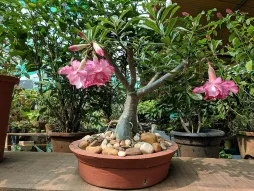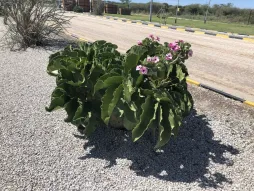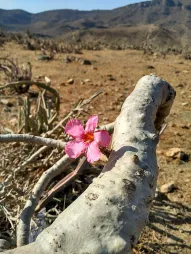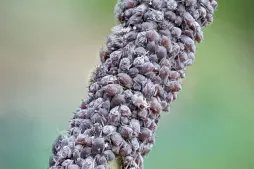Adenium oleifolium, the smallest of the desert roses
With its olive-like leaves and oleander-like flowers, Adenium oleifolium could be mistaken for a Mediterranean plant. Not so! This variety of desert rose comes to us from southern Africa and belongs to the Apocynaceae family.
How to recognize the desert rose Adenium oleifolium?
Adenium oleifolium is a semi-succulent shrub with an upright, bushy habit. Smaller than adenium boehmianum or adenium obesum, this desert rose measures barely 60 centimetres high at maturity.
The plant has a buried caudex from which stringy or rigid semi-aerial stems grow. The trunk branches out and bears branches with green or brown bark at the top.
Simple leaves grow in a spiral at the end of the branches. Some are sessile, while others are short-stalked. Linear and narrow, they measure up to ten centimetres long and only 1.5 wide. The green-gray leaf blades are covered with a fine down. Adenium oleifolium is a deciduous plant. In early winter, the leaves fall to limit evaporation.
From the very first days of spring, flowers bloom in cymes. Their five petals are fused together to form a central tube. Their open lobes give the flower a star shape.
Petal color varies according to hybrid and cultivar. Commercial specimens often have pale pink or red flowers. In the wild, they can be violet, magenta or two-tone. But it doesn't matter which variety: the throat of the flower is always darker in color than the petals, and striped with yellow.
Adenium oleifolium produces fruits composed of two fused follicles. They bear bristles at their tips, which help disperse the seeds.
Adenium oleifolium is toxic. The desert rose contains alkaloids, a substance that is very dangerous to animals if ingested, and irritating to the touch. Keep your plant away from pets and wear gloves when pruning.
Our maintenance tips
You can propagate your Adenium oleifolium by sowing or cutting. Sowing produces a plant identical to the mother plant. With cuttings, your new specimen will not develop a caudex.
Watering
Adenium oleifolium are the enemy of excess water. Before giving your specimen a drink, always make sure the soil is at least five centimetres dry.
Like many plants, the plant prefers rainwater. But it's fine with tap water. Just make sure it's at room temperature.
Remove any water stagnating in the cup under the pot. It can rot the roots.
Spray
Your adenium oleifolium hates wet foliage. You must not mist the plant.
Repotting
In spring, transfer your Adenium oleifolium to a larger pot, so that it can continue to grow.
Get a pot with holes larger than the root ball of your Adenium oleifolium.
Adenium oleifolium appreciate a light, draining substrate. You can plant your specimen in potting soil for cacti and succulents. You can also make your own growing medium by mixing equal parts potting soil and a draining material such as sand, perlite or pozzolan.
Place a layer of substrate at the bottom of the pot. Plant your Adenium oleifolium in the center. Then add potting soil. In young plants, the caudex grows better when buried. If your plant is less than four years old, bury two-thirds of it. If it's older, you can leave it on the surface.
Water generously to facilitate rooting.
Fertilization
You can stimulate the development of your plant during its growth phase, in spring and summer, with fertilizer.
Use a cactus and succulent or Mediterranean plant fertilizer to encourage the growth of your Adenium oleifolium.
Prune
Remove wilted flowers. If you can't cut the flower stem with your hands, you can use pruning shears. Remember to clean your tool beforehand to prevent disease transmission.
Seedling
Prepare a light, draining substrate, for example 50% potting soil for cacti and succulents, 25% pozzolana and 25% sand. Pour your mixture into plastic cups.
Plant your seeds, covering them with two to three centimetres of substrate. You can put several seeds in the same pot.
Sowing is done in the air. Place your pots in a mini-greenhouse or cover them with a bottle or translucent plastic bag.
Mist the substrate regularly to keep it moist. Don't forget to air the pots a few minutes a day.
Cutting
Cutting is carried out during the strong growth phase, generally in spring and early summer.
Locate a healthy, flowerless branch. Cut a section with several leaves about 10 centimetres long. Use a clean, sharp tool to facilitate healing.
Leave your cutting to dry for 24 to 72 hours, until a callus forms.
In a pierced terracotta pot, pour a bed of clay balls or gravel to optimize drainage.
Prepare a mixture of one-third potting soil, one-third garden soil and one-third sand. Pour it into your pot, on top of the drainage layer. Plant your cutting and tamp it down.
Place the pot in a room where the temperature is always above 18 degrees. The location should be bright and out of direct sunlight. You can, for example, place your cutting behind a curtained window.
To avoid drowning the roots, always check the condition of the substrate before watering: the surface must be dry.
Diseases / Threats
Information
| Family | Apocynaceae - Apocynaceae |
| Type | Desert rose - Adenium |
| Species | Adenium oleifolium - Adenium oleifolium |
| Lifecycle | Perennial |
| Foliage | Deciduous |
| Exposure | |
| Substrats | |
| Planting methods |
In pots In tubs Bucket |
| Categories | |
| Tags |
Flowery Fritillary Toxic |
| Origin |
South Africa |
| Hardiness (USDA) | 11b |
| Leaf color |
|
| Flower colors |
|
Discover plants from the same family

Adenium obesum
Discover

Adenium boehmianum
Discover

Adenium dhofarense
Discover

Adenium multiflorum
Discover



















